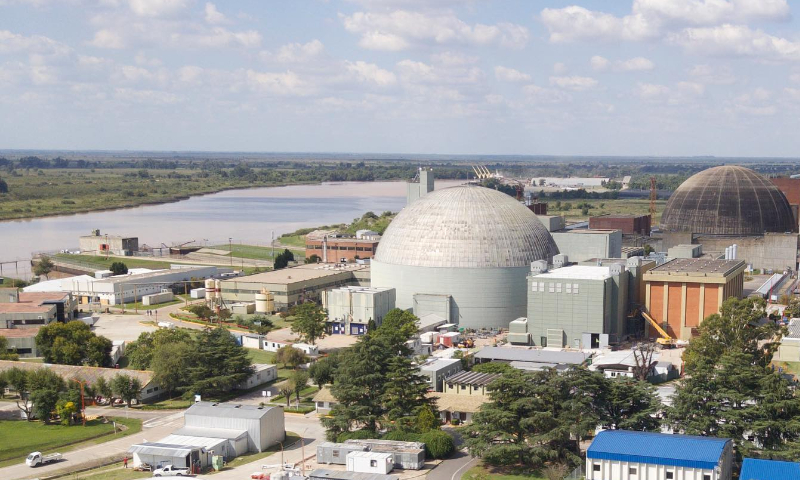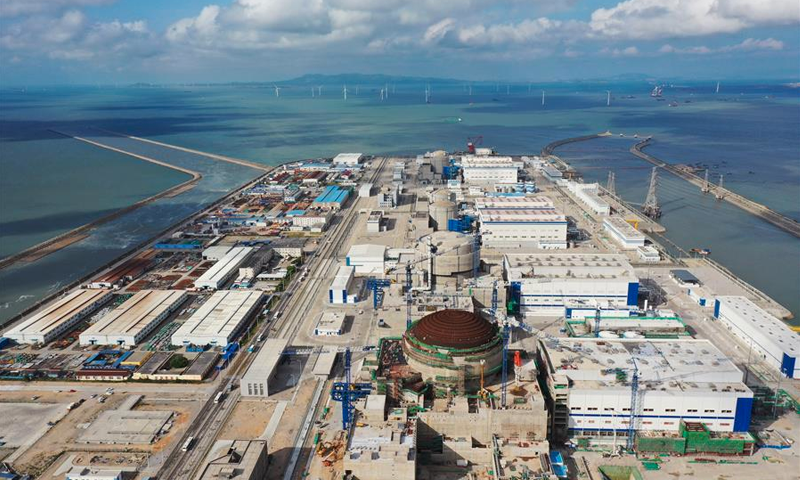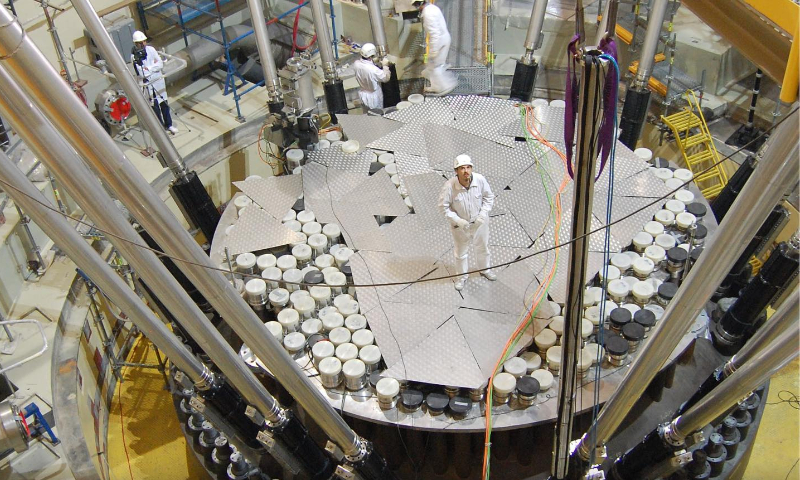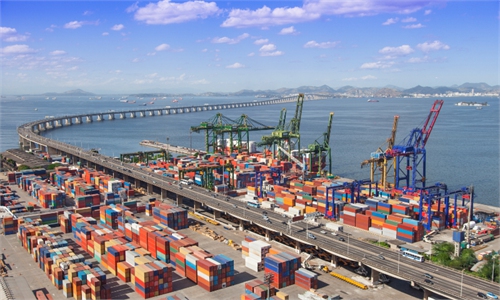China's nuclear technology to spur safe, reliable energy for Argentina, contrasts with US rhetoric: experts

The Atucha I Nuclear Power Plant in Argentina Photo: website of Nucleoelectrica Argentina S.A.
China and Argentina have been close partners for decades and such a relationship has been further strengthened under the Belt and Road Initiative (BRI), exemplified by the joint development of pillar infrastructure projects such as dam, powerhouse, and railway construction, which inject real impetus to the country's sustainable development.
However, such cooperation has made the US feel unease due to its fears of losing hegemonic stranglehold on the region.
On its recent and most blatant posturing campaign against Chinese cooperation with the Latin American country, the US sounded a false alarm on the Atucha III, a future mega nuclear power project, a cooperative project agreement previously signed by the China National Nuclear Co (CNNC) and an Argentine company in February, 2022.
In recent visits by US officials to Argentina including the president of the US Nuclear Regulatory Commission Christopher Hanson in April, efforts have been made to hype up the alleged risks of partnering with China in nuclear matters, according to media reports.
Experts said that US officials targeting Chinese projects show their increasing concern over the China-Latin America cooperation under the BRI, fearing a decline in US influence in the region.
This fear is rooted in the US's historical view of Latin America as "its backyard," Song Wei, a professor at the School of International Relations and Diplomacy, Beijing Foreign Studies University, told the Global Times on Tuesday.
It suggests that US investment goals are impure and politically-motivated, rather than a genuine attempt to assist regional countries like Argentina in achieving prosperity and are unjustifiable, not to mention the US often limits its efforts to lip service, the expert said.
Political-motivated meddling
On April 11, Hanson arrived in the Latin American country. Hanson visited the Atucha Nuclear Complex facilities and warned of potential risks and "inconvenience" of partnering with China in nuclear matters, Spanish media outlet Público reported.
The recent attempts of interference by the US also include claims that the technology provided is lacking in quality, doesn't meet with international standards, and that the project as a whole has design and safety issues, among other "concerns."
Atucha III is a 1200-megawatt reactor to be built at the existing Atucha Nuclear Complex. It will be the country's fourth nuclear power plant.
In February 2022, Chinese nuclear giant CNNC signed an agreement with Nucleoeléctrica Argentina to establish a nuclear station with CNNC's Hualong One technology, a third-generation pressurized water reactor, for the design, acquisition, and construction of the power plant.

Aerial photo taken on Aug 31, 2020 shows a panoramic view of Fuqing project in the city of Fuqing, southeast China's Fujian Province. Fuel loading started Friday at China's first nuclear power unit using Hualong One technology, a domestically developed third-generation reactor design, bringing the unit one step closer to operation. Photo: Xinhua
Joint efforts between China and Argentina in this project are regarded as a crucial step in nuclear power generation cooperation, as they aim to tackle climate change and attain global carbon neutrality goals.
Experts said that this instance of US attempts at impeding the construction of and discredit the quality and goals of cooperative projects associated with China's BRI in Argentina is yet another example of numerous malevolent actions employed to hinder China from collaborating with Latin American nations.
Moreover, the US' hyped concern over the Chinese BRI project citing quality, environmental impact concerns, and other issues is unjustifiable, analysts said.
China has a total of 54 commercial nuclear power units in operation, with a total installed capacity of 56.82 million kilowatts, ranking third in the world.
The country has 24 additional nuclear power units under construction, with a total installed capacity of 26.81 million kilowatts, ranking topmost globally, according to a blue paper released by the China Nuclear Energy Association on Wednesday.
Furthermore, China's nuclear power program has been recognized for its excellence in design, research and development, construction, and operation, placing it among the top players in the field internationally.
In terms of safety, Hualong One has met the new nuclear safety goals and requirements proposed by the National Nuclear Safety Administration after Japan's Fukushima nuclear power plant accident, and also met the highest international safety requirements, according to Science and Technology Daily.
The biggest feature of Hualong One is independent innovation, with complete independent intellectual property rights.
Economically and environmentally, the installed capacity of each Hualong One unit can reach 1.2 million kilowatts, and the annual power generation capacity is nearly 10 billion kilowatt-hours, which can meet the annual production and living electricity needs of a population of 1 million in moderately developed countries, which is the equivalent of reducing the consumption of standard coal by 3.12 million tons annually and cutting carbon dioxide emissions by 8.16 million tons.
Wang Youming, director of the Institute of Developing Countries at the China Institute of International Studies in Beijing, told the Global Times that the US' obstruction of the Argentine nuclear power plant project is nothing new.
"Whenever there is any big cooperation project between China and other countries, the US will make irresponsible remarks either by discrediting it or sending officials to disrupt it," Wang said.

The Atucha II Nuclear Power Plant in Argentina Photo: website of Nucleoelectrica Argentina S.A.
Argentina is not the only Latin American country working with China on infrastructure construction under the framework of high-quality BRI cooperation.
The reconstruction of the Eloy Alfaro International Airport in the Ecuadorian city of Manta, which was hit hard by a powerful earthquake in 2016, has enhanced the country's trade, tourism, and business ties with the rest of the world, the Xinhua News Agency reported.
The BRI has attracted significant investments through numerous cooperative projects in the countries involved, resulting in the creation of 420,000 jobs and the elevation of tens of millions of people out of poverty.
Empty rhetoric
In stark contrast to China's efforts, the US has consistently attacked and discredited BRI projects, while itself offering minimal practical advantages for regional economic growth.
For example, the US has made grand promises to kickstart the Partnership for Global Infrastructure and Investment, with a lofty sum of $600 billion allegedly earmarked for the initiative.
But the lack of any clear timeline or launch date for this ambitious scheme has led many to question the credibility of the proposal, with some dismissing it as nothing more than a hollow "numbers game."
By contrast, in recent years, China's cooperation with Latin America has expanded to benefit regional development. From 2000 to 2020, Chinese investment in Latin America increased 25-fold.



